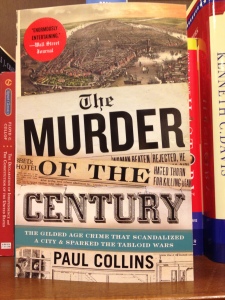
How many of you remember those dashing, mutton-chopped entrepreneurs you learned about during American History class in high school? Do the names Andrew Carnegie, Henry Clay Frick, or Cornelius Vanderbilt elicit bad memories of history tests you screwed up (because you couldn’t distinguish one 19th-century mogul from another)?
Sure, you had to memorize the various labor-union strikes many of these gentlemen busted so their trains, banks, and oil wells could continue to gurgle with Texas tea. But do you remember how these businessmen met their untimely ends and where they’re buried? I’ll say this: I don’t believe any American robber barons are neighbors with Oscar Wilde, Molière, or James Douglas Morrison at Pere-Lachaise in Paris.
The term “robber baron” allegedly originates from the 12th century. Per Investopedia, these medieval tycoons of the 1100s were:
“Unscrupulous feudal lords who amassed personal fortunes by using illegal and immoral business practices, such as illegally charging tolls to passing merchant ships.”
The phrase was revitalized during the 19th century’s Gilded Age of lucrative monopolies and financial hijinks…
It’s time to finish the (business) history lesson. Let’s add some high-caliber Trivial Pursuit knowledge (the Robber Baron Edition!) to your mental arsenal:
The First John Jacob Astor Never Sailed on the Titanic: Per Wikipedia, Johann Jakob Astor “was a German-born American businessman, merchant, fur trader, and inventor who was the first prominent member of the Astor family and the first multimillionaire in the United States.”
He was born in the quaint town of Walldorf, which sounds so familiar, almost as if it’s the name of a famous hotel in NYC about to be purchased by a Chinese insurance company.
Astor is one of the men who helped give life to New York City’s magnificent public library. (Bonus trivia: The two marble lions guarding the front entrance of the library were originally named Leo Astor and Leo Lenox. James Lenox was another of the gentlemen who co-founded the New York Public Library in 1911.)
John Jacob Astor (the first) died in 1848 of natural causes at the age of 84–not bad for a robber baron. He was buried at the gloriously historic Trinity Church Cemetery in Manhattan.
But his great-grandson, Colonel John Jacob Astor IV, was swallowed whole by the North Atlantic ocean on April 15, 1912. That was the date the RMS Titanic slipped forever to its underwater grave. Astor’s body was recovered by the crew of the CS Mackay-Bennett. He was laid to rest alongside other members of the Astor family at Trinity Church Cemetery.
Andrew Carnegie Had a Backbone of Steel and a Spine of Literature: What can you say about a brilliant “metal magnate” who was born in a one-room weaver’s cottage in Dunfermline, Scotland, in 1832? His “threads to steel” story is a fascinating one, made all the more alluring because he valued books, libraries, the arts, and philanthropy.
Would you believe the founder of Carnegie Steel funded approximately 3,000 libraries in his lifetime? His literary largesse extended to 47 states in the U.S. as well as Canada, the United Kingdom, the Republic of Ireland, Australia, New Zealand, the West Indies, and Fiji.
What started as the Carnegie Institute of Technology (CIT), with a $2 million donation from Mr. Carnegie in 1900, is now the world-famous Carnegie Mellon University in Pittsburgh.
Although Carnegie died of bronchial pneumonia (in 1919) in Lenox, Massachusetts, he was interred at the Sleepy Hollow Cemetery in North Tarrytown, New York. And get this: Andrew Carnegie is buried only steps away from Samuel Gompers (say who?). Mr. Gompers was a union organizer and well-known industrial rabble-rouser during the Gilded Age. Now that’s historical irony!
Marshall Field, from Massachusetts, Turned Chicago into His Personal Department Store: Young Mr. Field’s first job at a dry-goods store in 1851 led to the eventual reorganization of a multi-partner enterprise, renamed Marshall Field and Company.
Mr. Field transformed the 19th-century consumer experience from caveat emptor to “the customer is always right.” (Or something like that–the phrase is sometimes attributed to a former Field employee, one Harry Gordon Selfridge.)
It was challenging for me to source accurate information regarding Marshall Field’s demise. It is well known that he died in New York City on January 16, 1906, age 71.
But my friends at Wikipedia speculate that Field’s death resulted from “…a case of pneumonia contracted after playing golf on New Year’s Day with his nephew, his secretary, and Abraham Lincoln’s oldest son, Robert Todd.” To the entry’s credit, this not-particularly-scandalous information is identified as “dubious–discuss.”
After his funeral (on January 19, 1906), Marshall Field was buried at Graceland Cemetery. No, he’s not underground roommates with Elvis; this Graceland is in Chicago, Illinois.
Railroad Hotshot Jay Gould Has a Town and a Church Named for Him–How About You?: Jason (Jay) Gould was an upstate New Yorker (Roxbury) from humble, but not poor, beginnings. His robber-baron career started to accelerate in 1856 after he formed a tanning business (shoe leather, not artificial sunshine!) with a wealthy entrepreneur named Zadock Pratt.
They founded their company in a Pennsylvanian town renamed Gouldsboro in 1871.
Gould’s entry into the railroad industry began in 1859 with some speculative small-railway investments. This put him on track to become a storied railroad tycoon. He eventually wrestled the Erie Railroad away from Cornelius Vanderbilt (we’ll get to that gentleman another time).
Gould also dirtied his fingers in the sordid Tammany Hall political-corruption ring (courtesy of Boss Tweed).
In an attempt to dominate the gold market through speculative purchasing, Gould and fellow top-shelf gambler James Fisk contributed to the infamous Black Friday panic of September 1869.
Oh yes, Jay was a bit of a naughty boy–he ultimately lost control of the Erie Railroad. But then he gained enormous power in 1879 by purchasing western railroads, including a little ole heap of tracks called the Union Pacific.
Before he could celebrate his 60th birthday, Gould succumbed to tuberculosis on December 2, 1892. He was buried in the Bronx at Woodlawn Cemetery. Feel free to pay him and other Gould family members a courtesy call at Woodlawn’s Gould Mausoleum.
Before he passed, Gould helped fund rebuilding efforts for the Reformed Church in his hometown of Roxbury. Sometime after his death, the church was renamed the Jay Gould Memorial Reformed Church. It acquired protected status by being added to the National Register of Historic Places in 1988.
If ever you’re in the Catskills/Upper Hudson River Valley area, stop by Jay Gould’s personal church (in Roxbury)!
John Pierpont Morgan Almost Died a Watery Death on the Titanic (And Passed a Year Later): Born and raised in Hartford, Connecticut, J.P. Morgan entered the banking industry at the tender age of 20. Despite his spotty health, courtesy of a childhood bout with rheumatic fever, Morgan lived to the ripe old age of 75.
Besides dabbling in U.S.Treasury gold, newspapers and steel, J.P. was the man responsible for the 1892 merger (between Edison General Electric and Thomson-Houston Electric Company) that would create the behemoth known as General Electric.
Mr. Morgan also financed the creation of a business entity called the International Mercantile Marine Company; subsidiaries included the White Star Line, birth mother of the RMS Titanic.
After cheating death by cancelling his voyage on that doomed ship last minute, Morgan died in his sleep the next year (1913) while abroad in Rome, Italy. Yes, J.P. encountered a foreign death, but he had a stateside burial–you can visit him at Cedar Hill Cemetery in Hartford, CT.
(Bonus trivia: Plenty of other famous people, such as Katherine Hepburn, also “reside” at Cedar Hill Cemetery.)
Okay: Now are you having traumatic flashbacks of your first American History class in high school? Surely you’re aware there are other “heavy hitters” I didn’t dredge up for this post. But I’m not going to name those names just yet…
Did you enjoy this blending of 19th-century business trivia with the not-so-macabre details regarding how these enterprising entrepreneurs perished (and their final resting places)? Would a sequel in 2015 make for a read-worthy blog post?
I don’t want to write blog posts that bore you, so please, don’t hold back regarding any criticism. None of these men would be shy about telling me the truth–learn from their bold, robber-baronesque examples!
Lori Shapiro is the owner of By All Writes LLC, a business-to-business (B2B) writing, editing, and research company in Marlton, New Jersey. She revels in shielding her clients from the pain of writing their own print and web marketing or educational copy. Please call Lori Shapiro at 856-810-9764 or email By All Writes LLC at lori@byallwrites.biz for a no-obligation project quote today!










Sorry, comments are closed for this post.